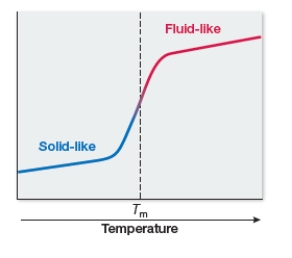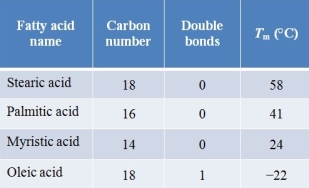Refer to the figure and table below. 
 At low temperatures, cell membranes become quite immobile and solid-like.If the temperature is gradually increased, a membrane undergoes small changes until a large change in fluidity is observed.The midpoint temperature corresponding to this large change is called the melting temperature.The graph shows how a cell membrane's melting temperature (Tm) is measured.The table shows melting temperature data collected from membranes composed of phospholipids containing different fatty acids.Which statement is consistent with these data?
At low temperatures, cell membranes become quite immobile and solid-like.If the temperature is gradually increased, a membrane undergoes small changes until a large change in fluidity is observed.The midpoint temperature corresponding to this large change is called the melting temperature.The graph shows how a cell membrane's melting temperature (Tm) is measured.The table shows melting temperature data collected from membranes composed of phospholipids containing different fatty acids.Which statement is consistent with these data?
Definitions:
Yerkes-Dodson Law
A psychological principle stating that performance increases with physiological or mental arousal, but only up to a point, after which performance begins to decrease.
Arousal
A state of being physiologically alert and responsive to stimuli, often leading to increased physical activity and cognitive awareness.
Hypothalamus
A small region of the brain that plays a crucial role in many important functions, including releasing hormones, regulating body temperature, and maintaining daily physiological cycles.
Ghrelin
A hormone produced in the stomach that stimulates appetite and signals the brain to increase food intake.
Q54: Which statement about membrane receptors in a
Q75: Refer to the diagram below illustrating one
Q84: When a severely dehydrated patient is brought
Q86: The diagram below shows the interface between
Q88: Which statement about the nuclear envelope is
Q95: Refer to the figure below. <img src="https://d2lvgg3v3hfg70.cloudfront.net/TB5650/.jpg"
Q106: The greater the affinity of an enzyme
Q107: Which statement about diffusion is false?<br>A) Facilitated
Q176: Refer to the figure below. <img src="https://d2lvgg3v3hfg70.cloudfront.net/TB5650/.jpg"
Q206: Which statement concerning chemical reactions and catalysts